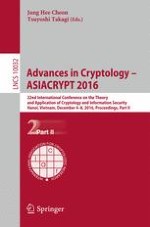2016 | OriginalPaper | Chapter
Towards Tightly Secure Lattice Short Signature and Id-Based Encryption
Authors : Xavier Boyen, Qinyi Li
Published in: Advances in Cryptology – ASIACRYPT 2016
Publisher: Springer Berlin Heidelberg
Activate our intelligent search to find suitable subject content or patents.
Select sections of text to find matching patents with Artificial Intelligence. powered by
Select sections of text to find additional relevant content using AI-assisted search. powered by
